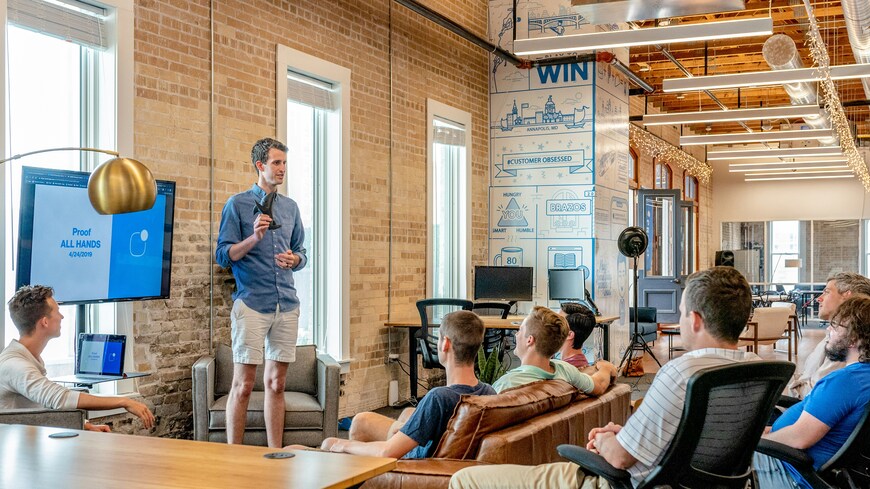What is The Difference between User Flow and Task Flow?
User flow and task flow are both vital in UX design. But, they serve different purposes. User flow focuses on the journey a user takes in a digital product design. It maps the steps from entering to completing a specific goal. It looks at how users navigate an interface design. They interact with various elements along the way. So, task flow zooms in on a smaller scale.
It breaks down specific tasks or actions. Users need to do them to achieve their business goals. It covers the steps users need to do tasks efficiently. Task variation is a key part of task flow. It accounts for different scenarios or paths. Users may encounter them while completing a task.The aim of this process is goal achievement. Each task in the task flow helps the overall objective that users are trying to fulfill. The diagram outlines the steps needed to achieve a goal. It guides users through the process. This helps lead to success and happier users.
Process pages are critical. They represent the stages or series of steps a user must navigate to reach their goals. Process pages have interactive elements, like forms or content. These help users interact and progress toward the goal. Designing process pages for clarity and efficiency can improve the user experience. UX designer can do this.
They can also help users complete tasks more easily. User flow shows the entire user experience that lies behind interacting with a digital platform, illustrating the sequence of steps, decisions, and interactions users undergo to achieve their goals. It encompasses the series of steps and interactions users undertake to accomplish their goals.Task flow fine-tunes interactions. It ensures smooth transitions between tasks. User stories and user personas play a crucial role in this process. These distinctions help designers tailor experiences. The experiences should be intuitive and engaging for users. The users move through a digital platform seamlessly. Yet, integrating persona-based design into user and task flows enhances the UX process by tailoring the design to the specific needs and preferences of the target audience. Persona-based design involves creating detailed profiles of typical users. The profiles include user action and their goals, preferences, behaviors, and pain points.
Understanding the concept of user flow in UX design
User flow in UX design refers to the path a user takes within a website or app to accomplish a specific goal. This involves understanding how users navigate the interface. They interact with simple user flow elements that work. They achieve their goals. Designers can map out the steps users take. They can then optimize the flow for efficiency and ease.
Understanding user flow is crucial. It helps create designs that guide users smoothly from one point to another. It helps designers anticipate user behavior, identify pain points, and improve overall usability. Designers can analyze entry points and actions taken. They can use this to tailor the experience to meet user expectations. Task flows don’t just focus on the linear progression of tasks. They can also look at exit points and alternative pathways that users may take. In essence, user flow is like designing a smooth journey for users as they move through a digital platform. It's about crafting an experience that lets users easily find what they need and complete tasks with little friction. Customer journey mapping provides a broader view, tracing the whole experience a customer has with a product or service, from first learning about it to post-purchase interactions. Adding customer journey mapping to the design process helps designers. It gives them insights into users' motivations, emotions, and touchpoints. They learn about these at each stage of their interaction. This approach is holistic. It allows for a deeper understanding of user needs and wants. It lets designers create flows that fit the customer journey and give a great experience. Customer satisfaction is at the core of this approach. It focuses on meeting and beating users' expectations at every touchpoint.Defining task flow and its significance in the design process
In UX design, task flow is the steps a user takes to do a specific task in an interface. It focuses on the efficiency and ease of navigation for users as they move through the system. By defining clear paths and user interactions, designers can guide users.
They can guide them towards achieving user goals easily. Understanding task flow and user flow importance is crucial. It helps in creating intuitive designs. They prioritize user experience. A clear task flow reduces confusion. It cuts frustration points. This leads to more user engagement and satisfaction. It is fundamental. It shapes how users interact with a product or service. It influences their overall perception. Designers map out task flows carefully. They do this to ensure that each step logically connects to the next. This provides users with a clear journey from start to finish. This structured approach enhances usability. It does this by simplifying complex processes into manageable tasks. This also enhances functionality and user satisfaction.Refining the design is crucial. It means improving the task flow step by step. This is based on user feedback, usability testing, and data analysis. By refining the design, designers can find and fix any issues or pain points that users may encounter. This ensures a smoother and more intuitive user experience.
Key components of user flow vs task flow
User flow and task flow are key in UX design. Each serves a clear purpose. User flow focuses on the journey a user takes in a product or platform. It maps the sequence of steps from entry to completion. It emphasizes understanding user behavior and product interaction.
Task flow is different. It focuses on the actions that a users need to do to reach their goals well. It breaks tasks into steps. It guides users through the path with clarity and ease. Complex user flows show many paths in an interface. Task flows focus on single tasks in those paths. Both play a key role in creating a smooth user experience. They do so by predicting user needs and enabling easy navigation.How Do User Flow and Task Flow Contribute to The UX Design Process?
User flow and task flow are crucial. They shape the user experience design process. Designers map out the user flow. They focus on how users navigate through a product or website to reach their goals. This also facilitates communicating and explaining design decisions to stakeholders and team members, fostering a shared understanding of the user experience goals and strategies.
Task flow emphasizes the sequence of actions. Users take them to complete specific tasks within the interface. By defining clear steps and interactions, designers can streamline processes and enhance usability. Task navigation is key to task flow. It dictates how users move between stages or screens to achieve their goals. Example of a task flow include an e-commerce checkout process. In it, users add items to their cart. They go to checkout, enter shipping and payment info, and confirm their purchase. Another example is a sign-up flow for a social media platform. Users enter their personal information. They verify their email or phone number and set up their profile. Adding the login process to the task flow ensures that users can access their accounts. They can then continue their journey within the platform. Signup optimization process is crucial. It streamlines registration to reduce friction and boost conversions. These task flow examples show how designers map the order of actions. They guide users through doing tasks fast and reaching their goals. Both scenarios often include an extra step: email confirmation. In it, users get a verification email to confirm their registration or purchase. It boosts security and ensures the validity of the user's account or transaction. Both user flow and task flow provide insights into user behavior. They allow designers to make informed decisions that prioritize user needs and preferences. Teams can create easy-to-use interfaces. They can do this by adding these flows early in the design process. The flows guide users to their objectives without friction.
Exploring the role of user flow in enhancing user experience
User flow plays a crucial role in enhancing the overall user experience of a website or app. Designers can map out the journey that users take through the interface. This lets them find pain points and improve pathways for smoother interaction. Understanding how users move from one step to the next allows for easy design choices that cater to user preferences and behaviors.
The decisions cater to their needs, reflecting the user actions and decisions they make throughout their interaction with the platform. Good user flow is well designed. It ensures users can do user tasks and with little friction. It guides them through the interface. This leads to higher engagement and satisfaction. Designers can create a natural user experience. They do this by focusing on a logical sequence of actions. Adding user flow analysis to the design process lets designers understand users' views. They can then tailor solutions that prioritize usability. This approach improves customer retention. It also fosters brand loyalty by providing a positive interaction environment.For example, in a social media platform, users may have the option to change their avatar. Adding this to the user flow ensures that users can easily go to the settings or profile section. They can then choose to change their avatar, and photo upload or choose a new image. Finally, users can save changes to apply their updates.
Once users like the new avatar, they could "save" or "update." Designers make the user experience better. They do this by smoothly adding avatar changes to the user flow. They also show clear prompts for saving. It also encourages users to keep using the platform.Utilizing task flow to streamline the design process
Task flow is a linear path like the backbone of UX design, providing a structured path for users to follow. By using task flow, designers can simplify the design process. They can also ensure that users easily navigate an app or website. This involves mapping out each step a user must take to complete a task. The focus is on efficiency and clarity. To make task flows, designers use design tools. They use the tools to create and see the flows. These design tools include software like Adobe XD, Sketch, Figma, and Axure RP. They offer features made for creating user flow diagrams and wireframes. Also, you can use tools like Lucidchart or Visio. They are for detailed flowcharting and process mapping. Designers can use these tools to make, change, and show task flows. This will lead to a more user-friendly digital experience. Designers carefully craft task flows. They are simplifying complex processes into steps for users. This improves the user experience. It also cuts confusion and frustration when using a product. Designers can create intuitive pathways for users to achieve their goals. They do this by paying attention to details. These include organizing information and arranging things in a specific order. Also, the placement of buttons and task flow navigation. This makes for a better experience for users. They can interact with the interface easily. Adding feedback loops and usability testing to the design process. This lets designers refine the task flow. They can refine it until it's optimally usable. Optimizing task flow is key. It ensures users can do tasks fast and without obstacles.Integrating user flow and task flow for a cohesive design strategy
Integrating user flow and task flow is key. It creates a design strategy that serves both users and business goals. By combining the two elements, designers can ensure a holistic approach to UX design. It focuses on efficiency and user satisfaction. User flow is complex about the steps users take to do tasks in an interface. Flow is a series of organized steps that users follow to accomplish specific tasks within a digital interface. Task flow is about organizing those tasks in a sequence. The flows work together well. They guide users through their journey on a website or application.
Task sequence is the structured arrangement of tasks in the task flow diagram. We expect users to complete them in the outlined order. Defining the task sequence clearly helps designers. It guides users logically and intuitively. This makes the usability and user experience better. By matching user flow to task flow, designers can improve usability.
They can also enhance the user experience. This integration allows for easier navigation. It leads to more engagement and successful conversions. Conversion rates are a key metric in assessing the effectiveness of this alignment. You will do this by analyzing how users move through the task flow. You will look for any bottlenecks or points of friction. Designers can then make informed adjustments. This will improve conversion rates. Incorporating both aspects into the design process makes every interaction purposeful. It helps them contribute to achieving desired outcomes. Designers know how to blend user flow and task flow well. They will deliver better digital experiences. They will be more cohesive and successful.What are The Similarities between User Flow and Task Flow in UX Design?
User flow and task flow in UX design share common ground. But, they serve distinct purposes. Both aim to guide users through a digital experience. They ensure it is efficient and clear.
UX communication is key. It bridges the gap between these two parts of design. It involves conveying the user flow and task flow well. This is to stakeholders, team members, and clients. It ensures they all understand the design goals. They understand how the goals help the user. Both user flow and task flow diagrams map the user journey from start to finish. They outline the steps for completing a specific goal or task.
This visualization helps designers understand the interactions users will have with the interface. Both user flow and task flow aim to streamline navigation for users. They reduce confusion and boost usability. By predicting user needs at each stage, designers can create easy paths. These paths enhance satisfaction. Designers can leverage these similarities. They should create a cohesive strategy that puts user experience first.
Identifying common elements in user flow and task flow diagrams
In UX design, user and task flow diagrams share common elements. Designers often use them to map out the journey. Both types of diagrams have stages.A user will go through to complete a product or service interaction. These stages help show the order of actions users must take. They must take them to complete a task quickly.
They use linear diagrams. These diagrams are like flowcharts or process maps. These stages or steps show them. They do so in a clear and structured way. A node or box visual representations each step in the user flow. Arrows connect them to show the flow of interaction. Linear diagrams show the user's journey.
They highlight decision points, branching flows, and potential loops. Wireframes are often added to these diagrams. They show a detailed layout and functionality at each stage. Wireframes help designers and stakeholders see the actual interface elements. These include buttons, forms, and content sections. They see these elements in the context of the user flow or task flow. This helps clarity and understanding of the user experience. UX wireflows take this further. They combine wireframes with user or task flows. Icons, arrows, and notes are common in user and task flow diagrams. They show direction and add context to each step. Visual cues are crucial. They guide users easily along the desired path. Both user flow and task flow diagrams use color coding. Different hues can show actions or highlight key decisions during the interaction. This visual hierarchy helps users understand the progression within the design more intuitively. Designers can spot these shared elements in user flow and task flow diagrams. Then, they can make clear and tidy visuals. These visuals help to improve the user experience.Analyzing user journey within both user flow and task flow
When designing user and task flows, understanding the user journey is crucial. User flow focuses on the overall path a user takes to accomplish a goal on a website or application. It maps each step from entry to completion. It considers interactions and decision points along the way.
The main goal of this process is task completion. The flow diagram is a visual roadmap. It guides users through the steps to achieve their goals. On the other hand, task flow zooms in on specific tasks within the broader user flow. By breaking down each action users must take, designers can streamline processes. This makes them more efficient. Analyzing both user and task flows helps designers see how interfaces work. They also see how the user interfaces help achieve their goals. By examining these journeys closely, designers can find pain points. They can also find opportunities for improving the design process. This analysis helps create intuitive pathways that guide users seamlessly towards their goals. Understanding user journeys boosts UX. It does this by improving navigation and usability.Examining the shared goal of guiding users through a seamless experience
In UX design, user flow and task flow share a common goal. They guide users through a seamless experience. The goal is to make the journey easy for every user. They are interacting with the interface. By planning the steps from start to finish, designers can make sure each step feels easy and makes sense.
They must carefully layout the steps. The goal is the same in both cases. It's about making things easy for the end-user. Whether it's navigating a website or a task in an app. User flow diagrams map the paths users may follow. Task flows outline the actions needed to reach goals. These visuals help designers see how users will move through stages of interaction. By considering user behaviors and preferences, designers can craft experiences. They can anticipate needs and guide users to their goals. They can do this without unnecessary barriers or confusion. Reaching this goal boosts satisfaction. It also makes digital platforms more usable.How Can Designers Create Effective User and Task Flows?
Creating good user and task flows is vital. It makes a seamless user experience. To make a clear user flow, start by mapping the steps a user would take to reach their goal on the platform or website. This may involve understanding user behavior and anticipating their needs throughout the journey.
Clear navigation paths and intuitive interactions can help streamline the user flow. By simplifying complex tasks into manageable steps, designers can enhance usability and engagement. It's crucial to prioritize visual simplicity and efficiency when designing task flows. They guide users through specific actions effectively. Using best practices helps. These include consistent design, clear visual hierarchy, and feedback. They can improve the user experience. Regular testing and iteration are key. They refine user and task flows are typically design based on real-user feedback. By optimizing these flows all the time. Designers can ensure an easy and satisfying interaction for users. The users will be interacting with their product or service.
Steps to develop a comprehensive user flow in UX design
Creating a full user flow in UX design has many key steps. They ensure a smooth and easy experience for users. Start by defining the goals and objectives of the product or website. This will help you understand what actions users should take. Research how users behave. Do this through surveys, interviews, and analytics.
These will give insights into their needs and preferences. Next, map the user journey from entry to conversion. Use flowcharts or diagrams. Find points where users interact with the interface. Expect roadblocks or detours. Use feedback and testing to refine your design. Iterate on it to improve the user flow. Keep improving the flow. Do this by using usability principles. These include simple, consistent, and clear design. Follow these steps closely. You can create a user flow experience. It will guide users easily through their interactive products or service.Creating a structured task flow diagram for efficient navigation
When creating a task flow diagram in UX design, clarity is key. It helps with efficient navigation. Start by identifying the main tasks users need to accomplish on your platform. Map out each step they will take from start to finish, ensuring a logical progression.
Guiding users through the steps of a task is crucial. It involves navigating them through the stages needed to complete a specific task. Use visual cues like arrows and labels to guide users through the flow. Keep the layout clean and organized, making it easy for viewers to understand at a glance. Consider incorporating user feedback into refining the task flow diagram for better usability.Website layouts play a crucial role in enhancing user experience. Designers can add wireframes of website layouts to the task flow diagram. This will show how users will move through the stages of interaction. Page layout is a key part of website design. It guides the layout of elements. These include navigation menus, content sections, and interactive design on each page. Test the task flow with real users to identify any bottlenecks or confusion points. Make adjustments as needed based on their insights and behaviors. Remember, a clear task flow can greatly impact user satisfaction. It affects their experience on your website or mobile apps.
Implementing best practices for user flow and task flow design
Using best practices for user flow and task flow design is essential. It creates a seamless and easy user experience. Designers can guide users through a cohesive journey on websites or applications. They do this by following structured steps. User flows are often developed in conjunction with task diagrams. To ensure success in UX design, it is crucial to integrate both user flow and task flow seamlessly. By understanding the differences and similarities between these two concepts, designers can create more comprehensive and effective design strategies.
These prioritize usability and task efficiency. Designers achieve UX mastery by balancing user flow and task flow well. User flow focuses on the journey users take within a digital platform. Task flow delves into the specific steps users need to achieve their goals. Including best practices will help. These include doing user UX research. It means focusing on user needs. You must test prototypes well and improve them based on feedback. They will lead to the development of effective user flows and task flows. Using these best practices in design improves the user experience. They can also drive engagement with their products or services.
